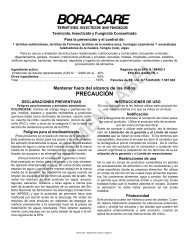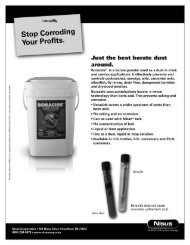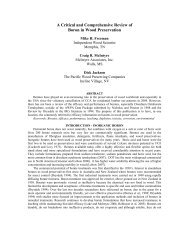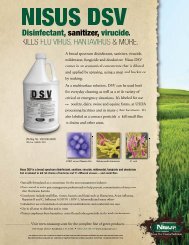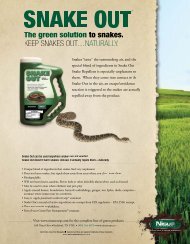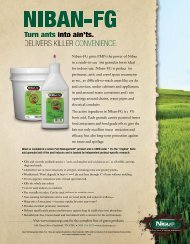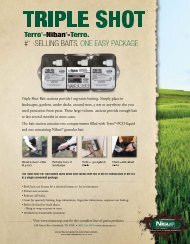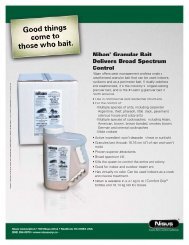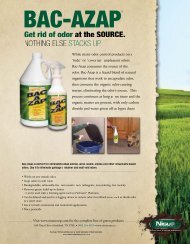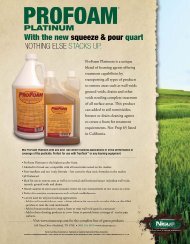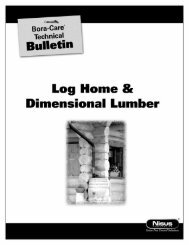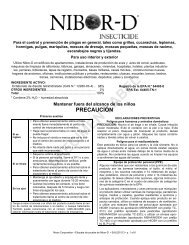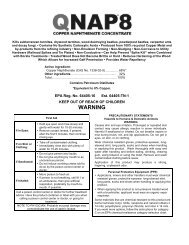NiBor-D Insecticide Label - Do My Own Pest Control
NiBor-D Insecticide Label - Do My Own Pest Control
NiBor-D Insecticide Label - Do My Own Pest Control
- No tags were found...
You also want an ePaper? Increase the reach of your titles
YUMPU automatically turns print PDFs into web optimized ePapers that Google loves.
Issue Date: 11/1999Revised Date: 11/2010Material Safety Data SheetNIBOR-D ®<strong>Insecticide</strong>Health Emergencies: CHEMTREC ® (800) 424-9300SECTION I – COMPANY AND PRODUCTINDENTIFICATIONManufacturer:Nisus Corporation100 Nisus DriveRockford, TN 37853(800) 264-0870 Fax: (865) 577-5825Product name: Nibor-D ®Grade:TechnicalProduct use:Termiticide, insecticide, fungicideChemical formula:Na 2B 8O 13 4H 2OChemical name/synonyms: Disodium octaborate tetrahydrateChemical family:Inorganic boratesCAS registry number: 12280-03-4EPA registration number: 64405-8(Refer to Section I5 for TSCA/DSL Chemical inventory listing)SECTION II – COMPOSITION/INFORMATION ONINGREDIENTSThis product contains greater than 98 percent (%) disodium octaboratetetrahydrate, Na 2B 80 13•4H 20, which is hazardous under the OSHAHazard Communication Standard and under the Canadian <strong>Control</strong>ledProducts Regulations of the Hazardous Products Act (WHMLS), basedon animal chronic toxicity studies. Refer to Sections 3 and 11 fordetails on hazards.SECTION III – HAZARD IDENTIFICATIONEmergency overview: Nibor-D is a white, odorless, powderedsubstance that is not flammable, combustible, or explosive and has lowacute oral and dermal toxicity.Potential ecological effects: Large amounts of Nibor-D can beharmful to plants and other species. Therefore, releases to theenvironment should be minimized.Potential heath effects: Routes of exposure: Inhalation is themost significant route of exposure in occupational and other settings.Dermal exposure is not usually a concern because Nibor-D is poorlyabsorbed through intact skin.Inhalation: Occasional mild irritation effects to nose and throat mayoccur from inhalation of Nibor-D dust at levels greater than 10 mg/m 3 .Eye contact: Nibor-D is non-irritating to eyes in normal use.Skin contact: Nibor-D does not cause irritation to intact skin.Ingestion: Products containing Nibor-D are not intended foringestion. Nibor-D has a low acute toxicity. Small amounts (e.g., ateaspoonful) swallowed accidentally are not likely to cause effects;swallowing amounts larger than that may cause gastrointestinalsymptoms.Cancer: Nibor-D is not a known carcinogen.Reproductive/developmental: Animal ingestion studies in severalspecies, at high doses, indicate that borates cause reproductive anddevelopmental effects. A human study of occupational exposure toborate dust showed no adverse effect on reproduction.Target organs: No target organ has been identified in humans.Signs and symptoms of exposure: Symptoms of accidentalover-exposure to Nibor-D might include nausea, vomiting, anddiarrhea, with delayed effects of skin redness and peeling. Thesesymptoms have been associated with the accidental over-exposure tothe chemically related substance boric acid by ingestion or absorptionthrough large area of damaged skin.Refer to Section 11 for details on toxicological data.SECTION IV – FIRST AID MEASURESInhalation: If symptoms such as nose or throat irritation areobserved, remove person to fresh air.Eye contact: Use eye wash fountain or fresh water to cleanse eye. Ifirritation persists for more than 30 minutes, seek medical attention.Skin contact: No treatment necessary because non-irritating.Ingestion: Swallowing small quantities (one teaspoon) will cause noharm to healthy adults. If larger amounts are swallowed, give twoglasses of water to drink and seek medical attention.Note to physicians: Observation only is required for adult ingestionin the range of 4-8 grams of Nibor-D. For ingestion of larger amounts,maintain adequate kidney function and force fluids. Gastric lavage isrecommended for symptomatic patients only. Hemodialysis should bereserved for massive acute ingestion or patients with renal failure.Boron analyses of urine or blood are only useful for documentingexposure and should not be used to evaluate severity of poisoning orto guide treatment. Refer to Section 11 for details.SECTION V – FIRE FIGHTING MEASURESGeneral hazard: None, because Nibor-D is not flammable,combustible or explosive. The product is itself a flame retardant.Extinguishing Media: Any extinguishing media may be used onnearby fires.Flammability Classification (29 CFR 1910.1200):Non-flammable solid.SECTION VI – ACCIDENTAL RELEASE MEASURESGeneral: Nibor-D is a water-soluble white powder that may, at highconcentrations, cause damage to trees or vegetation by rootabsorption. At low concentrations it is a micronutrient. (Refer toEcological Information, Section 12, for specific information.)Land spill: Vacuum, shovel or sweep up Nibor-D and place incontainers for disposal in accordance with applicable local regulations.Avoid contamination of water bodies during cleanup and disposal.Spillage into water: Where possible, remove any intact containersfrom the water. Advise local water authority that none of the affectedwater should be used for irrigation or for the abstraction of potablewater until natural dilution returns the boron value to its normalenvironmental background level.Nibor-D is a non-hazardous waste when spilled or disposed of, asdefined in the Resource Conservation and Recovery Act (RCRA)regulations (40 CFR 261 ). (Refer to Regulatory information, Section15, for additional references.)SECTION VII – HANDLING AND STORAGEGeneral: No special handling precautions are required, but dry indoorstorage is recommended. To maintain package integrity and tominimize caking of the product, bags should be handled on a first-in,first-out basis. Good housekeeping procedures should be followed tominimize dust generation and accumulation.Storage temperature: AmbientStorage pressure: AtmosphericSpecial sensitivity: Moisture (caking)SECTION VIII – EXPOSURE CONTROLS / PERSONALPROTECTIONEngineering controls: Use local exhaust ventilation to keepairborne concentrations of Nibor-D dust below permissible exposurelevels.Personal protection: Refer to label for actual regulatory personalprotection requirements. Where airborne concentrations are expectedto exceed exposure limits (e.g. confined spaces), NIOSH/MSHAcertified respirators must be used. Eye protection, protective clothingand waterproof gloves may also be warranted under certain highexposure conditions.Occupational exposure limits: Disodium octaborate tetrahydrate(Nibor-D) is treated by OSHA, Cal OSHA and ACGIH as “ParticulateNot Otherwise Classified” or “Nuisance Dust”. The OSHA/PEL(Permissible Exposure Level) is 15 mg/m 3 total dust and 5 mg/m 3respirable dust. The Cal OSHA/PEL is 10 mg/m 3 . The ACGIH/TLV(Threshold Limit Value) is 10 mg/m 3 .SECTION IX – PHYSICAL AND CHEMICAL PROPERTIESAppearance: White, odorless, powderBulk density: 320 to 480 kg/m 3Vapor pressure: Negligible @ 20 0 C



